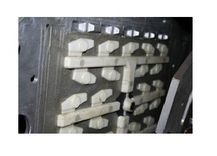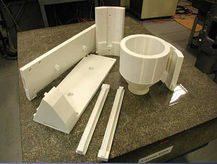- Commercial 3D printers & additive manufacturing solutions
- Order sample print
Sand Casting With 3D Printers
With 3D printing systems available from Stratasys, foundries can fabricate patterns with either Objet Polyjet technology or FDM Technology. This results in substantial savings in cost, labour and time, ultimately speeding new product development.The green sand casting process uses a mold made by pressing a pattern into a sand mixture. The pattern leaves a cavity into which molten metal is poured. This process works well for low–volume production. With automated equipment, it can be efficient for high–volume production. Three common types of sand casting patterns are:
- Loose patterns, which simply replicate the cast piece; patterns are not connected to other patterns or mounted on a plate.
- Cope and drag patterns, or split patterns, are like loose patterns with a gating system added and a split along the parting line.
- Matchplates are similar to cope and drag patterns except the cope and drag sides are combined into a single piece.
Producing sand molds and cast metal parts is relatively straightforward and suitable for automated methods that can reduce cycle time and labor. However, fabricating the patterns is often difficult, time-consuming and expensive. The most common approach is to produce aluminum patterns using CNC machining. The biggest problems with this approach are the high cost and lengthy lead time. The potential for problems, such as incorrect shrink compensation and design flaws, means the initial pattern often must be redone, which adds to the expense and lead time. It is not usually practical to machine the intricate gate and runner systems on CNC machines because testing is required to finalize the design. Instead, the gate and runner system is cut from Ren board or a similar material and then hand–carved and sanded to the finished shape. Constructing the gating system adds expense and lead time. This is where 3D Printing comes in to it's own.
Application Checklist
PolyJet or FDM patterns are a best fit for sand casting when:
- Molds are intended for prototype or production use
- Casting designs need verification
- Gate and runner refinements are likely
- Castings will be complex or large
Benefits of PolyJet and FDM patterns for sand casting include:
- Pattern cost reduction of 50 to 70 percent
- Lead-time reduction of 30 to 70 percent
- Faster design revisions
- Interchangeable gate and runner system
Steps
- 3D print the master: In CAD, design a master that will maximize the capabilities of inkjet or FDM. Print the master, which will become the pattern, with the best build parameters for the desired surface finish and strength.
- Accommodate parting: Mount the pattern on parting-line elements (which can be FDM or inkjet 3D-printed fixtures). The parting line helps avoid issues with undercuts.
- Mount the casting pattern and parting line elements on a wooden plate. The parting–line elements will be fixed in place to the plate.
- Apply a surface release agent on the 3D-printed master pattern.
- Create the mold: Pour sand around the pattern and parting line element and remove the pattern. A cavity appears in the shape of the pattern, the upper half forming the cope and the lower half forming the drag.
- Use the mold: Pour the molten metal in the cavity. Once it cools, it can be removed and finished.
Application Outline - PolyJet
FullCure materials, which work with Stratasys inkjet 3D printing systems, have good mechanical properties, allowing them to endure foundry environments and last longer. Sand casting facilities use inkjet technology to create mold patterns when they want high-resolution printing with exceptionally fine details and smooth surfaces right out of the printer, and because inkjet 3D printing offers materials that fit the requirements of this niche application. When using inkjet materials, a lacquer significantly hardens the pattern surface without affecting the finish. Check with a Stratasys application engineer for lacquer recommendations.
Application Outline - FDM
All of the thermoplastics that FDM technology uses have the high compressive strength required for green sand casting patterns. The surface finish of the FDM master can be optimized through build orientation and/or through a secondary process such as sanding. The Finishing Touch Smoothing Station uses a semi–automated process to smooth FDM parts to near–injection-molded quality. This also seals the mold surface, which keeps the release agent from penetrating and sand from sticking. The ability to build highly accurate, large, complex patterns fast and inexpensively makes FDM a clear advantage over traditional methods.
 Worcester (Head Office) 01905 458 000
Worcester (Head Office) 01905 458 000 3d@stanfordmarsh.co.uk
3d@stanfordmarsh.co.uk














